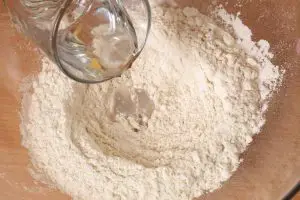Why Is My Bread Dry and Crumbly?
Whether you make homemade bread by hand or with a breadmaking machine, there is both an art and a science attached to the process. The truth is that it can take a few tries to get your homemade bread to look and taste just right. Not only do you have to include all the right ingredients but you have to make sure that each step of the breadmaking process is done just right, because even the tiniest error can result in a loaf of bread that no one is interested in eating.
One of the most common problems with homemade bread is when it turns out too dry and crumbly. While it may seem that this is a fluke and won’t happen again, the truth is that it could very well happen again if it happens once. If you’re convinced that you’ve done everything perfect but your bread still turns out this way, there are a few possibilities why this happens. You need to learn what makes your homemade or bread machine bread too crumbly before the problem goes away. Below are 5 actions that could help eliminate this problem once and for all.
You May Have Too Much Flour in Your Bread
While flour is important when you’re making bread, too much flour can make the final product too crumbly and dry. Working hard to get your dough neither too sticky nor too dry takes a bit of practice, but the key is to make sure that the balance of wet and dry ingredients in your bread is just right. When you’re kneading your dough, make sure that you add enough flour whenever it feels too sticky or wet, but add only small amounts at a time so that the dough doesn’t feel too dry when you’re done. This process should be a little easier if you add flour in very small amounts.
If you weigh out your ingredients ahead of time, including both wet and dry items, it can be a little easier. Just remember not to add too much flour when you’re kneading your dough because once it becomes too dry, you won’t be able to go back and change anything.
There Is Too Little Fat or Salt in the Bread
Both fat and salt are important for the bread to come out tasty and moist. If you’re asking yourself, why is my bread crumbly, it could be that the salt and/or the fats — meaning the shortening, olive oil or butter have not been applied in the proper amounts. If you’re following a special diet, it may be tempting to cut back on the amount of fat or salt that the recipe asks for, but making bread is not the time to do this. Bread needs both of these ingredients in order to retard the yeast, and retarding the yeast is what keeps the bread nice and moist.
Keep in mind that both fat and salt are usually included in the recipe in very small amounts, so it will not affect your diet if you add these ingredients to your recipe.
You Didn’t Let the Bread Cool Off Enough Before Cutting it
Diving into a warm piece of homemade bread is surely tempting, but if you don’t let the bread cool off enough before you cut into it, you can end up with dry and crumbly bread. Why? Because when bread first comes out of the oven, there is a certain amount of steam on the inside because it is still baking. When you cut into the bread too soon, that steam is released and the baking process stops, causing a lot of the moisture in the bread to disappear. This is why letting bread cool for the proper amount of time is so important.
As a general rule, let white bread cool for one hour and whole-wheat bread for two to three hours. And always use a serrated knife to cut the bread because these knives are specifically made to cut bread the correct way.
You Did Not Knead the Bread Long Enough
Kneading dough long enough is crucial to getting a great-tasting loaf of bread in the end, but if you do not knead it long enough, your bread’s texture can come out all wrong. While kneading dough can be a bit uncomfortable, it’s vital that it be done the correct length of time if you want your bread to come out just right. Most recipes call for two kneading times, with the first being ten minutes long and the second being two minutes or less. If you have to, set a timer so you’re positive that the kneading time is long enough. You won’t ever regret this decision because it always helps you knead the dough long enough to get moist, crumble-free bread.
You Did Not Use Enough Gluten
While gluten has gotten a bad rap lately, this is a vital ingredient when making bread. White flour has the most gluten, while whole-wheat flour has a lot less. This is one of the reasons why whole-wheat bread usually has a small amount of white flour in it. And when it comes to white flour, not all of it is created equally. Bread flour has the most gluten, which is why it is best to use this type of flour in your bread. The answer to the question, why does my homemade bread fall apart after it’s baked, could be reduced amounts of gluten, which you can correct by simply following the recipe to the letter and always making sure that you have enough white flour in your recipe.






